The Alocasia plant is also known as the African Mask plant an attractive foliage plant and houseplant capable of growing quite large if given enough humidity and extra light during the winter months.
Its unique foliage makes it an interesting houseplant and even more interesting in a landscape.
One of the newer African mask Alocasia hybrids grown from tissue culture
The African Mask plants call the South Pacific home, and many species come from the Philippines, India, Southeast Asia, and New Guinea. This tuberous perennial from the Araceae family holds broad-shaped foliage and some edible parts.
According to the International Aroid Society, plants of the family Araceae possess a bizarre mix of spathe and spadix which people see as its flower.At one time the genus of Alocasia was considered to be part of the Colocasia (elephant ear plant) but was reclassified.
The hardiness zones of this plant greatly depends on the variety. So you need to know first about their differences and types, before you can identify this.
African Mask Plant (Alocasia) and Colocasia Differences
One of the things that distinguish the Alocasia plant from the Colocasia plant is the Colocasia is edible.
Throughout the Pacific islands and Southeast Asia, the roots or tubers of Taro (Colocasia esculenta) are roasted or boiled and eaten.
Although the Alocasia has a very similar type root as the elephants ear plant, it is not an edible plant.
Eye Catching Leaves
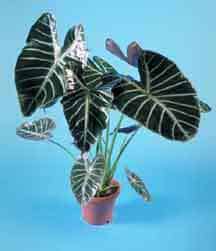 The demand for foliage plants as decoration in modern homes seems beyond limit.
The demand for foliage plants as decoration in modern homes seems beyond limit.
The Alocasia African mask plant (some think the plant looks like one) or Kris plant as the Alocasia is sometimes called is a plant meeting the demand.
Many of the 70 or so different Alocasia species have veins with contrasting colors that are clearly defined, dark green, and heart-shaped leaf which looks attractive, eye-catching and exotic.
Unique in coloring and bold in shape, Alocasias attract the attention of all who see them.
The combinations of bronze, green, silver gray and cream with corresponding variation in the shape of the leaves, make them truly gems among plants grown for their foliage.
Alocasias are still relatively uncommon for the average homeowner and a bit of sleuthing may be necessary to locate them. Although more are available due to tissue culture propagation.
Not All Houseplants
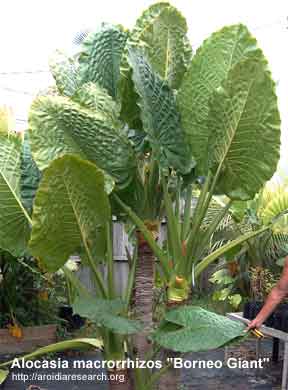 Alocasia Borneo Giant
Alocasia Borneo Giant
Many interested in Alocasia think they can all be grown as houseplants. But, there are some varieties which grow very tall with a leaf and stem reaching over 6′ feet. Much too big for use as a houseplant, maybe a conservatory plant!
Some do fine on a sun-porch with plenty of light, others require almost a greenhouse atmosphere to do well.
There are several varieties and hybrids like: Alocasia Amazonica which will grown well indoors with enough light and could use a little boost of artificial light during the winter months.
Big And Out Grown
If you are able to provide the right conditions (high humidity) to grow the African Mask plant indoors well, overtime, it can outgrow its space.
As the plant grows the leaves grow larger and the stems or petioles grow longer. This happens gradually over a period of a few years.
Varieties and Hybrids
As noted above there are over 70 species. Over the years there have been numerous hybrids made as well.
The first hybrid alocasias were first made over 100 years ago by European horticulturists. Popular Alocasia hybrids in the 1950’s were:
- Alocasia x Amazonia (Alocasia lowii Var. Grandis x Alocasia sanderiana) one of the most popular crosses
- Alocasia x Cantrieri (Alocasia cupera x Alocasia sanderiana)
- Alocasia x Sedenii [Alocasia lowii x Alocasia sanderiana)
- Alocasia x Morte- fontainensis [Alocasia lowii x Alocasia sanderiana).
Valued for their variegated colorful leaves and the ability to easily clone they Alocasia have created a renewed interest in them. Over 40 new cultivars have been introduced in the past few decades.
“The most notable cultivars include ‘Buko Park’, ‘ Alocasia Black Stem’, ‘Black Velvet’, ‘Corozon’, ‘Elaine’, ‘Fantacy’, ‘Frydek’, ‘Grandis’, ‘Nobilis’, ‘Polly’, ‘Purple Prince’, ‘Sarian’, ‘White Knight’, and ‘Wentii’.
Because of the effectiveness of tissue culture in generating desirable mutants, cultivar development in Alocasia now relies primarily on the selection of some clonal variants.” [source]
These new hybrids are all in an effort to produce plants that will grow indoors under normal lighting or create more unique plants for the landscape.
Alocasia Amazonia
Alocasia amazonica is a hybrid between Alocasia Sanderiana and Alocasia lowii var. Grandis and is one of the most striking and unique looking patio and houseplants.
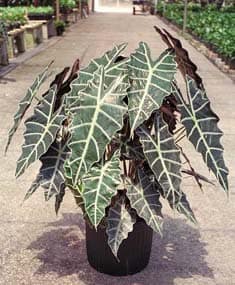 Their dramatic waxy, two-tone, arrow-shaped leaves are accentuated by whitish or pale green leaf veins. This standout, lush perennial plant can be grown from underground corms and loves lots of warmth, humidity and water.
Their dramatic waxy, two-tone, arrow-shaped leaves are accentuated by whitish or pale green leaf veins. This standout, lush perennial plant can be grown from underground corms and loves lots of warmth, humidity and water.
Under favorable conditions, Alocasia amazonica can reach 2′ in height and a spread of a foot or two. It blooms occasionally and can send up pups which fill out gardens quickly to form a dense clump.
Alocasia Macrorrhizos
A fast growing and invasive tropical plant found in regions with high temperatures. The alocasia macrorrhizos, also known as giant taro, originally came to these warm areas to serve as an ornamental plant.
Giant taro was first introduced in the Philippines. Around 1500 years ago, Polynesian explorers took this plant eastward until they arrived in Hawaii.
Now, the giant taro acts as a staple food in regions with no ability to raise traditional vegetables rich in starch such as potatoes due to the warm climate and high humidity.
This massive perennial holds foliage with sizes of 3 to 4 feet wide and stalks ranging from two to four feet long. The entire plant can reach 15 foot tall and ten foot wide. Its roots have the same taste as potatoes. You can eat them after boiling, dried or ground into flour.
Alocasia talihan Elmer ex Merr
This name is a synonym for the species Xanthosoma Sagittifolium, also called arrowleaf elephant ear. It’s a flowering plant that provides an edible, starchy corm.
This variety is popular in many cuisines — Puerto Rico, Bolivia, Costa Rica, Mexico, Nicaragua, Brazil, and more. Chefs use them in stews, soups, puree, and as ingredients for other local dishes. Its popularity even reached the far countries of Suriname and The Netherlands.
The arrowleaf elephant ear can also control weeds making it a good plant for reforestation areas.
You may also like –> The World’s Largest Flower Amorphophallus (Corpse Flower)
How To Propagate Alocasia – African Shield Flower
There are several ways to propagate Alocasia. One method is from the root cuttings (corms -little bulbs) the plant sends out. Another is by suckers cuttings.
Take the stem cutting with a sterile knife or razor making sure an “eye” is in each section. Dress the wound with a fungicide.
Plant the cutting or lay it horizontally on moist soil, lighting covered, keeping a temperature of around 75° degrees Fahrenheit.
Begin watering after sprouts start growing. Begin liquid feed after a couple months of growth.
You can also make use of the rhizomes, a growing horizontal underground stem. The best propagation works by splitting them up.
Kris Plant Pests
The Kris is the indoor plant alocasia. Indoors especially during winter the dry air can lead to spider mites, along with sections of the plant drying out.
For minor spider mite problems… wiping the leaves while applying a good forceful blast of water may be all that is required.
Mealybugs can also find their way to plants. A cotton swab with alcohol may do the trick. Alocasia can be tender so what you treat insects with, so be careful. Wipe the leaves regularly using a clean cloth or sponge to keep plants free of dust.
Flowers
The Alocasia are basically for “non-show”, with flowers which are “Calla-lily like” having the flower spike surrounded by bracts.
Buying Tips
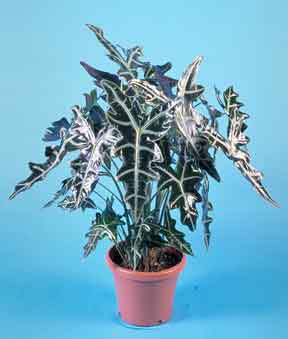
Alocasia plants are often in stores and garden centers during the spring and at other irregular times throughout the year.
The best time to purchase plants is in spring or early summer. It is often sold during the brighter warmer months.
This allows time for plants to acclimate and establish themselves before winter. It often rests in the winter time due to poor winter lighting.
With proper humidity and extra light during the winter Alocasia is not a difficult plant to grow.
African Mask Plant Care Tips
Size and Growth: The varieties grown as a “houseplant” can grow up to 4 feet tall, with leaves 20 inches long or more.
Each leaf begins growing from the ground on a long stem. Some varieties will produce a trunk as they mature and grow leaves of considerable size.
Flowering: Alocasias do flower with a “calla-like bloom” but are grown primarily for their leaves and the decorative value they provide. The flowers have no particular scent.
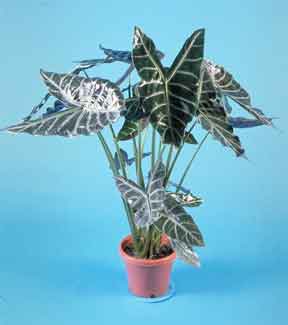 Light and Temperature: The Alocasia requires good lighting all through the year. During winter months the plant may “rest” often due to lower, poor or indirect light levels.
Light and Temperature: The Alocasia requires good lighting all through the year. During winter months the plant may “rest” often due to lower, poor or indirect light levels.
They also require loots or warmth. The landscape varieties can grow outdoors in direct sunlight. The “houseplant” varieties like bright light but only need partial sun.
Temperatures below 50° degrees Fahrenheit may cause the plant to lose leaves.
Watering and Feeding: Keep the potting mix and soil moist. It responds well to liquid feed delivered at half the recommended label dose.
Soil and Transplanting: Provide a well-drained soil for the plant. For planting in pots, use 2 parts peat moss or an African violet soil mix and 1 part perlite, will produce excellent results.
With potted plants a good layer of drainage material at the bottom of the pot can be beneficial. A small pot with poor soil can slow down plant growth.
When planting in the ground, with a good mix of organic material incorporated is advised.
Grooming: The plant requires no real grooming other than removing older leaves with a sharp knife as they whither and die off normally.
Propagating: Sucker, Tissue Culture, or division of root stock.
It has been noted that Alocasia is toxic like the popular Dieffenbachia Tropic Snow from the calcium oxalate in the stem. Children and pets should be kept away from the plant. Check out our tips on Dieffenbachia care.
As a longtime plant collector Anthuriums and Alocasias have always been dear to my heart. I’m always looking to discover more about these plants. Below are excerpts with minor edits of Alocasia Lowii as described in New and Rare Beautiful Plants – 1870.
Alocasia Lowii, Caladlum Veitchii,
Caladium Lowii, Low’s Caladium
Natural Order – Araceae
The very close relationships of Alocasia and Caladium, and the consequent impossibility of distinguishing the genera when the plants are quite young, accounts for the three names which the plant before us has respectively borne. Caladium Veitchii had been introduced to cultivation prior to the discovery of the plant before us, and in due time proved to be an Alocasia, and was re-named accordingly Alocasia Veitchii.
In the summer of 1862 Messrs. Low and Co., of Clapton, received from Borneo a plant which they believed to be Caladium Veitchii, and under this name they first presented some immature specimens of it at the Metropolitan exhibitions.
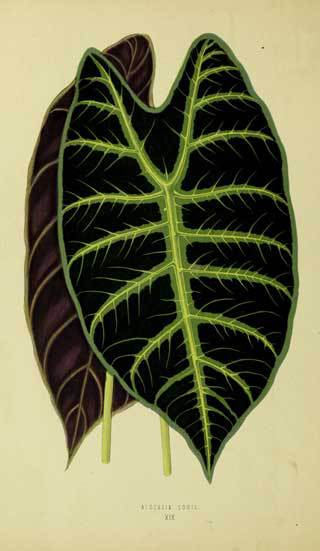 Drawing of Alocasia Lowii from New and Rare Plants 1870 – Larger image here
Drawing of Alocasia Lowii from New and Rare Plants 1870 – Larger image here
In due time it proved to be distinct from the plant bearing the name under which they received it, and hence it was re-named Caladium Lowii.
When the inflorescence appeared it proved to be not a Caladium, but an Alocasia, and finally it was registered and described as Alocasia Lowii, (Hooker,) as good a name perhaps as could be given it in these days of degraded nomenclature, a diagnosis being no longer a needful preliminary to the determination of a specific name.
Alocasia Lowii is one of the grandest plants of the remarkable family to which it belongs, and if not superior to Alocasia metallica, as we are inclined to think it is, at least equals that fine plant in solemn richness of coloring and majestic proportions, and is the best possible companion plant to that.
It is, like other Alocasias, an evergreen stove perennial plant, having a distinct, erect, rhizomatous stem, to which the sheathing bases of the upright leafstalks are attached. The leaves are sharply sagittate, a foot to a foot and a half long, and five to nine inches wide, the base divided by a deep sinus into a pair of oblong lobes.
The coloring of the leaf, as in the case of Alocasia metallica, suggests to the spectator that he is looking at some elaborate work of metallic art. It is poor praise perhaps to liken any work of nature to a work of art, yet these two plants have such peculiar appearances that we know not how to avoid it.
In Alocasia Lowii the midrib and its secondary ribs are of ivory whiteness, and coalesce with a thickened ivory white margin; the spaces between these ribs are of a deep green, and the under surface is a sombre purple. In its inflorescence it differs from others of the genus in being somewhat ornamental; at all events the spathes are upwards of four inches long, elegant in outline, and of the most snowy whiteness.
Image: Aroidia Research

 Alocasia Borneo Giant
Alocasia Borneo Giant


 Drawing of Alocasia Lowii from New and Rare Plants 1870 – Larger image here
Drawing of Alocasia Lowii from New and Rare Plants 1870 – Larger image here